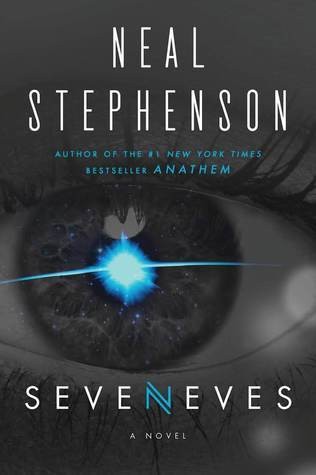“Seveneves,” Neal Stephenson. Hardcover, 880 pages. William Morrow Publishing, 2015. Audio read by Mary Robinette Kowal, Will Damron, 32 hours. (9 out of 10)

One of my favorite moments is when a science fiction book has immersed you so completely in that world that when you look up from it, you’re startled to see that the world you’re actually in is still…well, exactly what it was when you started reading. That moment happened to me so often in Neal Stephenson’s “Seveneves” that I was starting to worry I had a problem. Well. A new problem.
I saw other reviews of this 880-page monster from people I trusted, but with a busy summer I didn’t get around to reading this before now. Even then, I listened to the audio version, read by two different performers and clocking in at 32 hours. It’s the kind of book where it’s an investment of time that you hope pays off. “Seveneves” does. Multiple times.
The book begins in our very near future, when our moon…breaks up. Is destroyed. An unknown “agent” (it’s never discovered if it’s manmade, natural, or alien in origin) splits the moon into seven large chunks. Just a frightening curiosity at first, it soon becomes clear that the pieces of moon are going to continue spinning, colliding, and breaking into smaller pieces. These will eventually succumb to Earth’s gravity as a “Hard Rain” — burning the entire surface of the planet, and destroying all life. It’s a terrifying scenario, and considering the Hard Rain is supposed to begin within two years, one that will spell the end of humanity.
From here the book is split into three parts: Part One is preparing for the end, with the resources of the entire planet expended to put as many people up into space as possible. The International Space Station becomes the heart of a structure called the Cloud Ark – a system of many small spaceships which will hopefully survive catastrophe. Who gets to be saved, how they get to be saved, and their role in the future of mankind becomes the driving storyline for most of this section. Part Two begins with the Hard Rain; watching the destruction of Earth and transitioning into a new beginning for humanity. Can the survivors of the catastrophe survive each other? There’s a five thousand year jump between Parts Two and Three. The Earth is finally habitable again; who will inherit it?
This is a massive book, and although it could have been broken up into a trilogy of smaller ones, this was a more satisfying read. The characterization of the heroes in “Seveneves” make you root for them whether or not you actually think you would get along with them in real life. I loved Andy Weir’s “The Martian” because we got to see Mark Watney “sciencing the shit out of” problems so he could survive with limited resources–a good chunk of “Seveneves” is individuals and teams doing that. Not to let one guy survive for a year, but to preserve humanity when our home was no more. Like Andy Weir, author Neal Stephenson stays as close to what would be realistically available to these people as possible. When the moon breaks up, the International Space Station isn’t too far removed from our own. The solutions the scientists, astronauts, and politicians come up with are credible, and make you wish NASA had more of a budget, or our politicians more vision. Probably both.
…makes you wish NASA had more of a budget, or our politicians more vision
There are unexpected turns of fortune for individuals and families of characters in “Seveneves.” There were times I was sure someone was going to live/die, and then they didn’t, and when they did/didn’t, it was suprising. Sometimes heartbreaking. One of the things I loved about this book is that 5,000 year jump. Seeing how exactly the human race of the future was impacted by decisions made in our day. Seeing what the implications of such an extinction event are to religion and politics and human emotion and ambition. If I look back 5,000 years, that’s just before the pyramids at Giza were being built. Looking forward 5,000 years is an exercise in optimism and the attempts to understand humanity and what makes us–us. I’m glad Stephenson engaged in it, so that we can as well.
While most of the book is a page-turner (or whatever the audio equivalent is)(driveway moments?), there are sections in Part Three that drag more than I wanted it to. Some of that is that we lost all points of reference; where there was strong connective tissue between Parts One and Two, most of that is lost before Part Three. As the story picks up again, Part Three eventually has mysteries of its own that are as delightful and suspenseful as the disasters of Part One and Two. Stephenson’s vision is large, his imagination intriguing. By the end of “Seveneves” I felt like I had been through the highest and lowest points of humanity’s greatest adventure. If you’re looking for a new sci-fi book that isn’t tied to some kind of franchise, and you’re willing to take the time for something more than a beach read, “Seveneves” may be it.